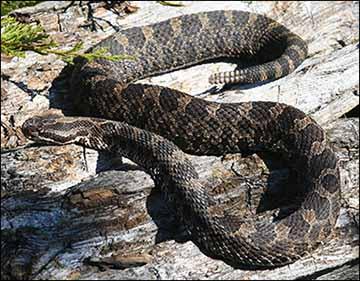The venomous reptile is one of the smallest rattlesnakes in the United States
The eastern massasauga rattlesnake (Sistrurus catenatus catenatus), finally has a draft recovery plan as required by law, and the U.S. Fish and Wildlife Service is seeking public comment on its plan to help bolster the venomous reptile's populations in their native habitat.

USFWS
Eastern massasauga rattlesnake.
The Eastern massasauga rattlesnake is one of the smallest rattlesnakes in the United States and was listed as threatened under the Endangered Species Act in 2016. It is the state of Michigan's sole venomous snake.
Some key initiatives to the draft plan include:
- Healthy eastern massasauga rattlesnake populations are conserved in sufficient number and distribution to ensure the species’ long-term viability. That is, the species is able to recover from disturbances and fluctuations in the environment (for example, stochastic events such as fire, flooding, and storms, as well as normal variation in rainfall and temperature). Maintaining these healthy populations will require protecting sufficient quantity of high quality habitat and the reduction or management of threats at those sites.
- Eastern massasauga rattlesnake populations occur across longitudinal and latitudinal gradients to maintain evolutionary drivers such as gene flow and natural selection. Maintaining existing genetic diversity and the diversity of selection pressures experienced by eastern massasauga rattlesnake populations will conserve the eastern massasauga rattlesnake’s ability to adapt to future changes in its physical (for example, habitat, climate) and biological (for example, predators, competitors, diseases) environment.
- Eastern massasauga rattlesnake populations occur in sufficient number and distribution to guard against catastrophic events (such as widespread drought, flooding, and disease) wiping out portions of the species’ adaptive diversity or the species as a whole.
The snake has suffered from a variety of causes, mostly man made, including habitat loss; an increase in woody invasive species that disrupt's the snake's habitat structure; flooding; drought; snake fungal disease; and persecution by humans who don't understand the value of these venomous animals.
Snake Fungal Disease Changes Skin Microbiome of Eastern Massasauga Rattlesnakes
Top 10 Venomous North American Snakes
As required by law, the USFWS has published the draft plan and is seeking comment. The comment period ends march 27, and any public comments must be turned into the U.S. Fish and Wildlife Service’s Chicago Field Office by that date.
For more information or to mail your comments, contact
USFWS
Chicago Illinois Field Office
230 South Dearborn St., Suite 2938
Chicago, IL 60604
Phone: 312-485-9337
Shawn_Cirton@fws.gov



